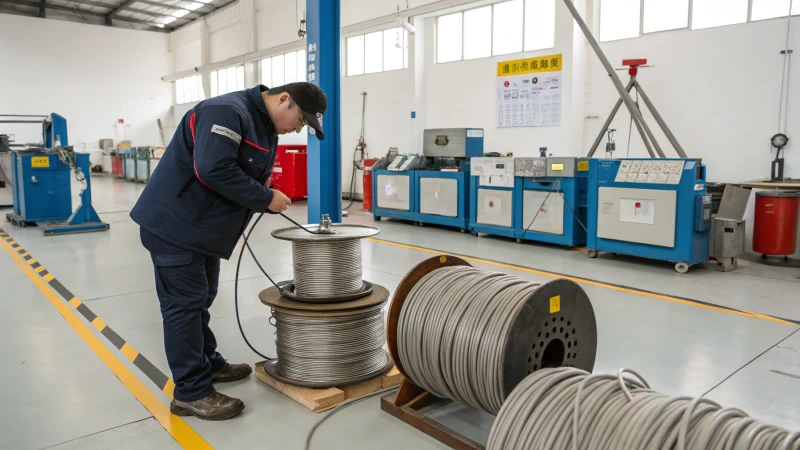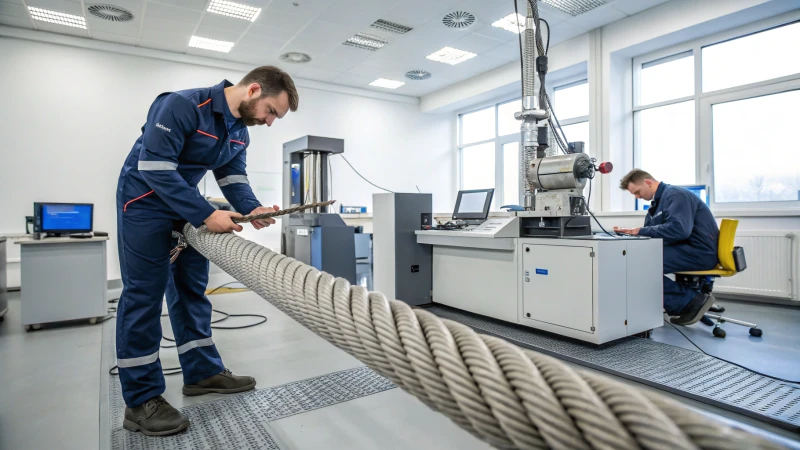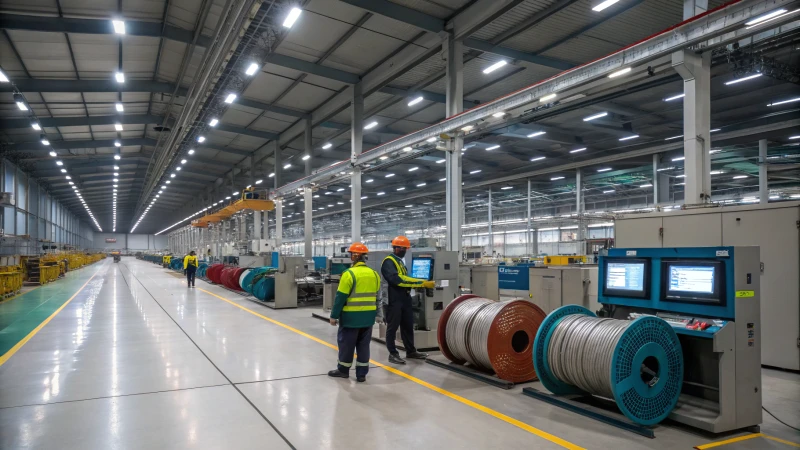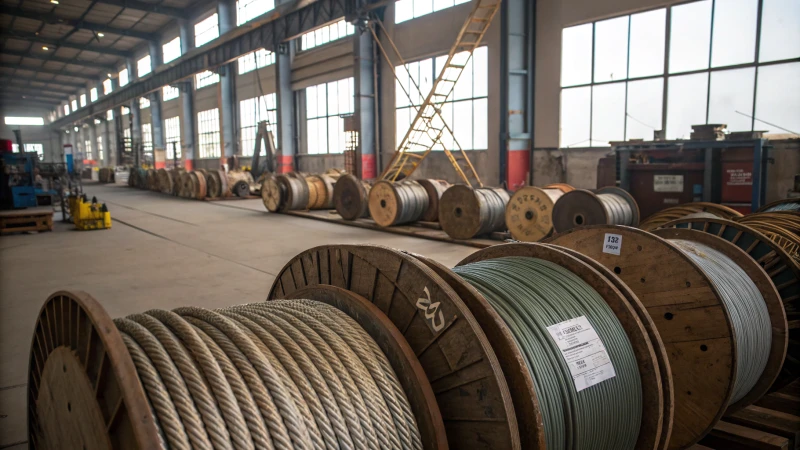
Ever wonder what it takes to ensure that steel wire ropes are both safe and reliable?
Quality control in steel wire rope manufacturing involves thorough testing and inspection methods, like tensile strength and fatigue tests, paired with visual checks. Adherence to global standards such as ISO 2408 and EN 12385 ensures these ropes meet high safety and reliability benchmarks.
I remember the first time I walked through a steel wire rope factory. The scale of the operation was overwhelming, yet fascinating. Each step in the process seemed like an intricate dance, all geared toward ensuring the final product could handle whatever challenges it faced. From automated tests that tirelessly check for surface defects to the meticulous manual inspections, every detail mattered. I realized then how vital these quality control measures are, not just for compliance but for the peace of mind they offer to industries relying on these ropes daily. Let's delve deeper into how these standards are maintained, turning raw materials into reliable lifelines for countless applications.
All steel wire ropes undergo tensile strength tests.True
Tensile strength tests are standard to ensure durability and performance.
ISO 2408 is unrelated to steel wire rope standards.False
ISO 2408 specifically outlines standards for steel wire ropes.
What advanced testing techniques ensure the quality of steel wire ropes?
When it comes to steel wire ropes, advanced testing is the backbone of quality assurance, ensuring safety and reliability in every strand.
Advanced testing techniques in steel wire rope manufacturing involve tensile strength tests, fatigue testing, and non-destructive testing (NDT) methods like magnetic particle inspection and ultrasonic testing. These techniques ensure that the ropes meet industry standards for reliability and safety.

I remember the first time I encountered the intricacies of steel wire rope manufacturing. It was a maze of machinery and precision, and the concept of tensile strength was a revelation. Imagine a scenario where every single wire is tested to its limits, ensuring that it can bear the weight of our expectations—literally.
Understanding Tensile Strength Tests
Tensile strength tests are like a rite of passage for steel wire ropes. They’re pulled until they can’t hold on any longer, revealing the maximum load they can carry. This process is crucial in industries like construction and mining, where the margin for error is razor-thin. Understanding tensile strength1 is essential for these applications.
Fatigue Testing for Longevity
Fatigue testing is akin to running a marathon with weights—it simulates the relentless wear and tear ropes face over time. By identifying weaknesses early on, manufacturers can ensure these ropes won’t give out at a critical moment. In my experience, knowing a rope’s fatigue resistance can be the difference between success and setback. Exploring fatigue testing2 provides insights into longevity.
Non-Destructive Testing (NDT) Methods
Non-destructive testing was a game-changer for me. It’s like getting an MRI for your ropes—using methods such as Magnetic Particle Inspection (MPI) to find hidden flaws without a single cut. Ultrasonic Testing (UT) goes even deeper, using sound waves to detect internal inconsistencies. These techniques are essential for maintaining the rope's integrity while ensuring safety.
- Magnetic Particle Inspection (MPI): Detects surface and subsurface flaws by applying magnetic particles to a magnetized wire rope.
- Ultrasonic Testing (UT): Uses high-frequency sound waves to detect inconsistencies within the rope’s structure.
Exploring NDT methods3 enhances safety and reliability.
Automated Testing Equipment
The introduction of automated testing equipment is like having an ever-vigilant guardian watching over every aspect of production. It continuously checks wire dimensions, surface defects, and uniformity, minimizing human error and ensuring that each batch meets the highest standards.
Adherence to Industry Standards
Compliance with ISO 2408 and EN 12385 standards is not just about ticking boxes; it's about guaranteeing quality. These standards lay out specific protocols and metrics necessary for safe industrial applications. For me, understanding these guidelines is key to navigating the global market landscape. Learning about industry standards4 ensures competitiveness.
| Testing Method | Purpose | Commonly Used For |
|---|---|---|
| Tensile Strength Test | Assess load-bearing capacity | Construction, Mining |
| Fatigue Testing | Determine lifespan under stress | Heavy Machinery, Cranes |
| Magnetic Particle Inspection | Detect surface/subsurface flaws | Shipbuilding, Offshore Rigs |
| Ultrasonic Testing | Identify internal inconsistencies | Aerospace, Power Plants |
Each of these testing methods plays a crucial role in ensuring steel wire ropes not only meet but exceed performance expectations in their demanding environments. It's this rigorous testing that gives me peace of mind when sourcing materials for challenging projects.
Tensile strength tests determine a rope's load capacity.True
Tensile tests measure the maximum force a steel wire rope can withstand.
Ultrasonic testing damages the wire rope during inspection.False
Ultrasonic testing is non-destructive, preserving the wire rope's integrity.
How does automation improve quality control in wire rope production?
Ever wondered how wire ropes achieve such impeccable quality? Let me take you behind the scenes of how automation is changing the game in wire rope production.
Automation enhances quality control in wire rope production by using technologies like sensors and AI for real-time monitoring and rapid defect detection. This reduces human error and boosts efficiency, ensuring consistently high standards.

Real-Time Monitoring and Analysis
In wire rope production, real-time monitoring facilitated by automation allows for immediate detection of irregularities. Picture this: sensors lining the wire rope production line, diligently checking every inch for irregularities. These sensors monitor tension, diameter, and surface conditions, feeding data to a central system where AI algorithms swoop in to detect defects early. This technology5 helps maintain uniformity across batches, thereby enhancing the overall product quality.
Precision Measurements
Automated systems take precision to a whole new level. Think about laser measurement tools that ensure each wire strand is perfect in diameter and length. It's as if each rope has its own tailor, ensuring not a millimeter is out of place. Not only does this precision minimize wastage, but it also guarantees compliance with industry standards like ISO 2408 and EN 12385.
| Measurement Tool | Feature | Benefit |
|---|---|---|
| Laser Measurement | High accuracy | Ensures consistent product size |
| Tensile Testing | Automated loading sequences | Meets industry safety standards |
Imagine the confidence you can have knowing each rope you use meets these strict criteria.
Defect Detection and Correction
One significant advantage of automation is its ability to detect and correct defects quickly. I remember hearing about a system that can spot surface defects like cracks in real-time—it's almost like having a sixth sense for imperfections. Once detected, automated correction mechanisms such as rerouting defective ropes for re-processing can be initiated without halting production.
Reducing Human Error
While human expertise remains invaluable, automation reduces the strain of manual inspections, cutting down on errors. By incorporating automation, the reliance on manual inspection is significantly reduced. This integration6 results in higher consistency and reliability in the final product.
Enhancing Efficiency and Safety
Imagine an operation that runs tirelessly, enhancing both efficiency and safety. Automation not only improves quality control but also enhances operational efficiency by operating continuously without fatigue risks—unlike manual labor. Moreover, they keep workers safe by handling hazardous tasks themselves.
For industries like construction and mining where top-notch wire ropes are crucial, adopting these automated systems ensures products consistently meet rigorous safety and performance standards.
Automation reduces human error in wire rope production.True
Automated systems minimize manual inspection, lowering human error risk.
Manual inspection is more precise than automated systems.False
Automation offers precision measurements difficult to achieve manually.
Why Are Industry Standards Crucial in Quality Assurance for Wire Ropes?
Ever wondered why wire ropes need to meet specific standards before they’re used in construction or mining?
Industry standards for wire ropes, like ISO 2408, ensure safety and reliability by mandating rigorous testing and quality benchmarks. These standards minimize risks of failure in demanding applications, guaranteeing that every wire rope meets essential performance and safety criteria.

Understanding Industry Standards for Wire Ropes
Industry standards such as ISO 2408 and EN 12385 are crucial as they provide guidelines for manufacturing, testing, and performance requirements of wire ropes. These standards ensure that wire ropes have the necessary tensile strength, resistance to fatigue, and uniformity.
| Standard | Description |
|---|---|
| ISO 2408 | Specifies requirements for steel wire ropes used in general applications. |
| EN 12385 | Focuses on safety requirements for steel wire ropes used in lifting equipment. |
I remember the first time I had to source steel wire ropes for a project. It was a bit daunting—who knew there were so many specifications? Standards like ISO 2408 and EN 12385 weren't just numbers; they were assurances that the ropes could handle the stress and strain we'd put them through. Imagine relying on something that might snap under pressure—not a pleasant thought, right?
Benefits of Adhering to Standards
By adhering to these standards, manufacturers can assure clients that their wire ropes are reliable and safe. This is vital for industries like construction and mining, where the integrity7 of equipment directly impacts safety.
- Safety: Compliance with standards minimizes the risk of accidents caused by rope failures.
- Quality Assurance: Regular inspections and tests ensure that the ropes perform well under stress.
- Performance Consistency: Standardized testing ensures uniform performance across batches.
When manufacturers stick to these standards, it’s like getting a stamp of reliability. I’ve seen firsthand how this impacts industries like construction and mining, where a tiny slip-up can lead to massive failures.
Testing Protocols for Quality Assurance
Rigorous testing protocols are integral to meeting industry standards. Wire ropes undergo various tests—tensile strength tests, fatigue tests—and visual inspections to ensure they meet industry standards. It's like putting the ropes through a boot camp before they face real-world challenges.
- Tensile Strength Test: Measures how much weight a rope can handle before it breaks.
- Fatigue Test: Assesses rope durability under repeated stress cycles.
- Visual Inspection: Detects any physical defects or irregularities because sometimes appearances do matter.
Understanding these testing protocols8 allows buyers to make informed decisions about the quality of wire ropes, ensuring they select products that meet both industry benchmarks and specific application needs.
ISO 2408 is for lifting equipment ropes.False
ISO 2408 specifies requirements for general application steel wire ropes.
Adhering to standards minimizes rope failure risks.True
Compliance with standards ensures safety and reliability, reducing accidents.
What Challenges Do Manufacturers Face in Maintaining High Quality?
Ever wondered what keeps manufacturers up at night? It's the relentless pursuit of maintaining high quality amidst a sea of challenges.
Manufacturers face challenges such as supply chain disruptions, technological advancements, and compliance standards in maintaining high quality. Addressing these requires strategic planning, technological integration, and adherence to industry regulations.

When I first stepped into the world of manufacturing, it felt like being in a thrilling yet daunting puzzle game. Every day brought new challenges that tested our ability to maintain the high quality we promised our clients. Let's dive into some of these hurdles.
Supply Chain Disruptions
Imagine this: you're all set for a big production run, and suddenly, your main supplier can't deliver the essential materials on time. It's like planning a grand dinner only to find out the grocery store is closed. In manufacturing, supply chain disruptions9 can throw a wrench in the works. Over the years, I've learned to have backup suppliers and invested in tools that give me real-time visibility of my supply chain. These steps have been lifesavers, allowing us to keep production rolling smoothly.
Technological Advancements
Technology can be both a boon and a challenge. I recall when we decided to integrate AI10 into our quality control processes. The potential was exciting, but it also meant retraining staff and overhauling existing systems. Balancing innovation with efficiency was tricky, but seeing how technology enhanced our product quality made it worth every sleepless night.
Compliance Standards
Navigating through compliance standards feels like a never-ending maze. The constant updates and requirements can be overwhelming. However, regular audits and comprehensive training sessions have helped us stay ahead. I remember the relief and pride when we passed our first ISO 900111 audit with flying colors. It reaffirmed that our hard work was paying off.
Human Factors
Despite all the technology and processes in place, human error is something we can't entirely eliminate. I once witnessed a minor oversight during production that could have led to significant issues. That's when we decided to double down on training and integrate more automation12 for repetitive tasks, which significantly reduced errors.
Environmental Concerns
In today's world, sustainability isn't just a buzzword; it's a necessity. I was initially skeptical about how we could maintain high-quality standards while being eco-friendly. But with innovation in materials and processes, we've managed to make our production more sustainable without compromising quality. It's a challenge that pushes us to think creatively and responsibly.
Summary Table: Challenges and Solutions
| Challenge | Solution |
|---|---|
| Supply Chain Disruptions | Diversify suppliers, use visibility tools |
| Technological Advancements | Invest in AI/IoT, train personnel |
| Compliance Standards | Regular audits, staff training |
| Human Factors | Automation, comprehensive training |
| Environmental Concerns | Innovate material usage, waste management |
These challenges have shaped me into a more resilient and strategic thinker. Each hurdle is a learning opportunity, pushing us to innovate and improve continuously.
Supply chain disruptions lead to increased production costs.True
Interruptions in supply chains can delay production, increasing costs.
Compliance standards have no impact on manufacturing quality.False
Compliance ensures safety and quality, impacting manufacturing processes.
Conclusion
Quality control in steel wire rope manufacturing involves rigorous testing, adherence to standards like ISO 2408, and automation to ensure safety, reliability, and performance across various applications.
-
Learn how fatigue resistance impacts the durability and performance of steel wire ropes in long-term applications. ↩
-
Discover how NDT methods enhance safety by identifying flaws without damaging the wire ropes. ↩
-
Discover how NDT methods enhance safety by identifying flaws without damaging the wire ropes. ↩
-
Understand the ISO 2408 standards to ensure compliance with international quality requirements for wire ropes. ↩
-
Explore how cutting-edge technologies are integrated into wire rope manufacturing to improve quality control and efficiency. ↩
-
Understand how automation minimizes human error in production processes to ensure consistent quality. ↩
-
Learn why adhering to safety standards is critical in construction to prevent accidents and ensure reliability. ↩
-
Discover various testing methods used to ensure the quality and durability of wire ropes. ↩
-
Learn strategies to handle supply chain disruptions for consistent manufacturing processes. ↩
-
Explore how AI and IoT technologies enhance manufacturing quality control. ↩
-
Understand essential ISO standards that ensure quality in manufacturing. ↩
-
Discover how automation minimizes human errors in manufacturing processes. ↩

